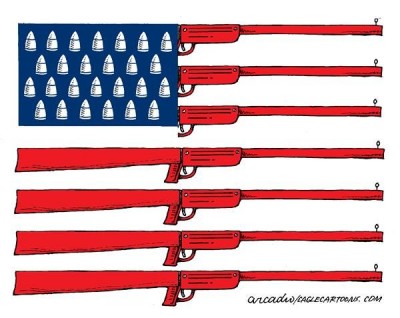The Killings in Oregon: Business as Usual

Normalised mass violence has become the unmentioned subject of US school syllabi. Teacher’s meetings and academic retreats must be getting longer and more perturbed: How do those in a university setting cope with an armed assailant who will take a dozen lives in a short span, and then perish?
Twenty four hour reporting loves such phenomena. It is crack violence for whoring reporting. It seemed most appropriate that the 10 deaths, repeated aerial shots of provincial Umpqua Community College, police and control centres, should be run around the clock on Oregon, even as Russian bombings of supposed ISIL sites in Syria were taking place. The latter commanded outrage that Russia was destabilising an already perilous situation, potentially undermining US-sponsored anti-Assad groups.
The former, on the other hand, saw a rehearsed pattern, a Pavlovian dog scenario that plays out in the theatrical bloodbath of gun, massacre and response. What matters is that nothing changes. Each group has a role to play in the theatre of inaction.
From the start of the interview fest, UCC and its surrounds were idealised as America’s sweet retreat, the vast shield against a national darkness. The community college was depicted as an escapist place of learning in rural Oregon. In such an Eden, such events do not happen.
There are the convenient illusions, those suggesting that gun killings take place elsewhere, where social decay is inexorable. Gun free areas operate. Controls are accepted. All of these are the insensible measures based on the idea that mass murdering weapons in civilian communities can be managed.
The gunman, Chris Harper Mercer, burst this illusion in several, literal ways. There were thirteen weapons recovered in the aftermath of the shootings, six at the school, and seven at home. Mercer also had body armour to add to his guerrilla styled arsenal. He was also, it is claimed by some of the survivors, interested in ascertaining the religion of those he shot, delivering Christians from their earthly existence.
The language of regulation is also as confused as the sentiment, legitimising the shooting culture by distinguishing what is an “active” shooter to what is not. The shooter was considered “active” which presumes that he was one by profession, as millions of others. Repeatedly, this “active shooter” went from room to room.
Then come the social media scourers and the vultures hoping to understand the assailant. There, after all, must always be a reason, a deep, metaphysical underpinning as to why one kills. Did he leave a manifesto of worth? Did he give us a sense of his murderous credo in advance? He was deemed to have, like many of his generation, an unhealthy interest in social media platforms. He was on a “chat board”. He spoke about imminent mayhem which was ignored. The very nature of such discussions were desensitised.
While some analysts will be averse to examine the system behind the shootings, the anti-socialising context, if you will, is hard to ignore. Angst and ennui become manifestations of total, expressive violence. There are no genuine discouragements, because at its heart, the US loves guns. But even psychologists, notorious for stumbling on this subject, admit that separating the potential school shooter from the standard disaffected school student is nigh impossible.[1]
Those worried about the effects of American power may derive rueful satisfaction at the murderous elements that gun culture produces, even in learning communities. President Barack Obama has noted that the rate of such killings in the US is 297 times more than Japan, 49 times more than France, 33 times more than Israel.
The president’s fifteenth statement on mass shootings in America was also a reflection of automated response. The nature of such violence, he observed, has numbed the entire mechanism of response. The reporting is routine. Obama’s own response is routine. The conversation in the aftermath is routine. The gun lobby response is routine. He asked the gathered media to consider how many Americans had perished in terrorist attacks to those who had lost their lives to gun violence.
The securitisation of the learning environment is certainly one of the most conspicuous features of the gun violence culture. A criticism from the security fetishists regarding UCC was that it lacked a heavily armed presence. This reveals the great paradox of US gun culture: the only things that should be regulated are places where gun owners may be found, rather than the guns themselves. As Douglas County sheriff John Hanlin has previous claimed, gun control was an “indisputable insult to the American people.”[2]
Portland Police have already promised to add extra officers to area schools after the UCC shootings. And even as Obama gave his address, the routine re-exerted itself. Security poured in. The FBI and associated agencies crowded the campus. Chillingly, it resembled tactics of combating a resourceful insurgent.
The individual incentive means that this becomes a problem of individuals. All sides partake in this, hoping to peer into an individual mind in the hope of localising a problem, or to unearth what social element caused the being to implode. The most troubling feature of the UCC shootings, however, point to no distinct ideology, or understanding. In killing, shallowness can be just as vital as the greatest political and religious projects.
Dr. Binoy Kampmark was a Commonwealth Scholar at Selwyn College, Cambridge. He lectures at RMIT University, Melbourne. Email: [email protected]
Notes
[1] http://www.livescience.com/25666-mass-shooting-psychology.html
[2] http://www.theguardian.com/us-news/2015/oct/02/oregon-shootings-douglas-county-sheriff-john-hanlin

